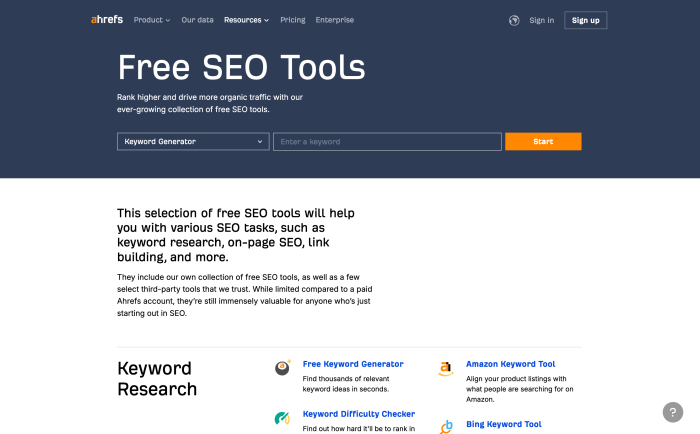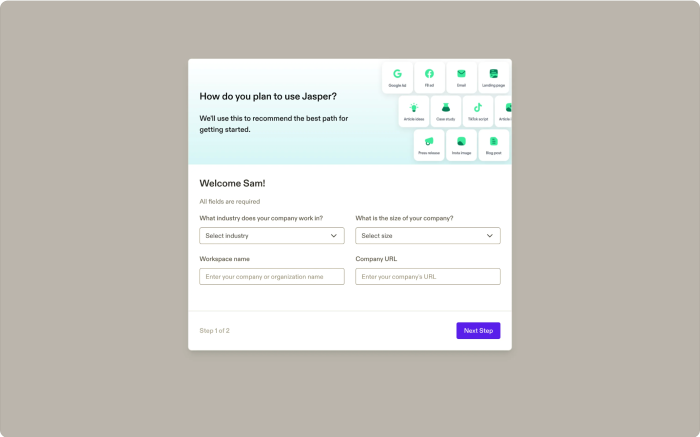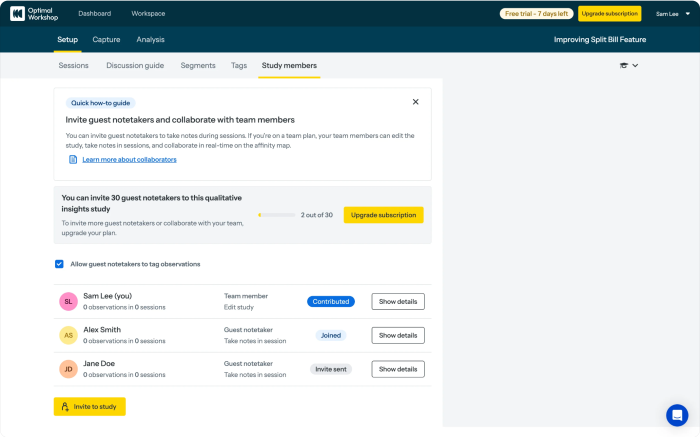Product led growth is a business strategy where your product does the selling for you. Instead of relying on a sales team to chase leads, product-led companies let users experience the product firsthand through a free trial or freemium model. In a product-led growth model, your product is THE channel to drive key KPIs like revenue, adoption, engagement, and churn.
Software purchases have come a long way since it first moved to the Cloud. Sales cycles have gotten shorter and shorter to the point where now the software does the selling itself. We, the customers can simply sign up for a new product, play around with it, and if we like it, we take out our credit cards and pay on the spot. Stripe's mission of increasing the GDP of the internet played a big part as SaaS companies were able to add billing into their product with just a few lines of code. As a result, product-led growth started to get more and popular. So what is product led growth?
Product led growth is a business strategy where your product does the selling for you. Instead of relying on a sales team to chase leads, product-led companies let users experience the product firsthand through a free trial or freemium model. It's way different from the old-school sales-led approach where a sales rep would talk your ear off about features.
In a product-led growth model, your product is THE channel to drive key KPIs like revenue, adoption, engagement, and churn. As you can guess, your product team plays a crucial role in driving customer acquisition and revenue growth. Successful PLG companies spend a lot of time and resources on creating amazing product experiences that gets users hooked from the moment they use the product.

“Product-led growth (PLG) is a strategy that focuses on product, UX, and users to drive revenue via self-service, viral loops, lower barriers to entry, and user-generated content.” - Pulkit Agarwal, CEO, Chameleon"
It's all about building a system that makes product growth compound exponentially, and that too at scale. According to Forbes, companies using PLG grew 25% faster than others.
Product led growth starts from the moment the user signs up for your product. Each and every action the user takes in their journey is meticulously designed. There's a whole bunch of things that goes into designing the PERFECT product led growth model. And in this essay, we'll show you everything you need to know about creating one for your business.
Let's dive in.
Benefits of product led growth strategy
PLG is just efficient. The software industry is built on scalability. And PLG is growth at scale, combined with the powers of compounding. When done right, a successful PLG strategy can unlock unprecedented growth levers.
Successful product-led growth benefits include:
A customer-centric product, smoother UX, and better user value
Fast, autonomous customer acquisition
Higher customer lifetime value & lower churn rates
Lower customer acquisition costs (CAC)
Better cross-team collaborations & holistic product development
Improved customer satisfaction scores (CSAT) and net promoter scores (NPS)
More efficient and scalable growth
Difference between product-led growth and sales-led growth strategy
Now that we’ve covered the basics of PLG, let’s compare it to more traditional approaches, like sales-led growth.
Sales-led growth depends on the expertise of sales teams, while PLG focuses on letting the product itself drive revenue.
Two very different strategies. So how do you differentiate between them—and how do you confidently choose one that’s going to work?
Product-led leads the way for us, hands-down. And we’re not the only believers:

“Marketing, sales, support, and account management teams should be empowered by the product to discuss the value offered at every step of the customer journey. Marketing’s goal is to get prospects to use the product, sales work to understand the needs of prospects and educate on how the product meets those needs.”
It’s great advice to bring all departments together in the pursuit of a healthy product-led growth model. A product-led growth model relies less on developing relationships and more on leaving your product to do the talking.
A sales-led Go-To-Market (GTM) approach relies heavily on outbound sales, personal relationships, one-to-one meetings, customized sales processes, and long cycles.
It can have high customer acquisition costs, and puts pressure on marketing teams to get leads through the door as they try to hit their metrics but not necessarily helping sales hit theirs.
The sales-led approach also leaves plenty of room for silos: often life boating marketing, sales, and customer service off to find customers and safe ground, while abandoning engineering and product teams in a shipwreck of “we need it by tomorrow” because “I have a feeling our customers want” and “I saw a TikTok.”
Product-led strategies remedy these chaotic sales-led repercussions by tying teams together with data and mutual goals, while putting the user experience at the center of it all—rather than individual team metrics.
Aspect | Sales led growth | product led growth |
Driver | Sales team relationships | Product experience |
User Journey | Guided by sales reps | Self-service exploration |
Time to Value | Weeks to months | Minutes to hours |
Cost Structure | High CAC, sales commissions | Lower CAC, product development |
Scalability | Limited by sales team capacity | Highly scalable |
Best For | Complex, high-ticket products | User-friendly, self-serve solutions |
Take Dropbox as an example. They gained traction by offering a free version that users could instantly try. On the other hand, traditional enterprise storage providers relied heavily on sales teams to close deals, which led to longer sales cycles and higher costs.
How to implement a Product-Led Growth strategy
Transitioning to a product-led growth (PLG) approach means rethinking your organization to center around the product experience.
Phase | Key Activities | Expected Outcomes |
Assessment | Analyze the current product experience and pinpoint friction points | Clear insights into gaps and opportunities |
Infrastructure | Set up analytics tools and user tracking | A strong base for data-driven decisions |
Product Improvement | Enhance onboarding and introduce self-service features | Faster time-to-value for users |
Measurement | Monitor metrics like PQLs, CAC, CLV, and retention rates | Data to measure and guide growth |
Once the foundation is in place, the focus shifts to aligning team roles with PLG goals. Restructure teams to create cross-functional groups that blend product development, customer support, and data analysis.
Traditional sales and marketing roles adapt to support the product-led strategy. For example, Slack reorganized its teams to prioritize product analytics and user experience, which improved their customer acquisition efforts.
Here are a few actionable tips on how to implement a PLG strategy:
1. Turn Your Product Into Its Own Growth Engine:
Your product shouldn't just be something users consume—it should actively spread itself. The best distribution strategies don’t rely on ads or outbound efforts; they’re built right into the product itself. Take Webflow as a prime example. When users create a site on Webflow’s free plan, they get a “webflow.io” subdomain and a visible “Made in Webflow” badge on their site. Every time someone visits that site, they’re subtly introduced to Webflow—free exposure, built-in virality. This isn’t an accident. It’s product-led distribution in action, where the product itself becomes a marketing channel, effortlessly bringing in more users.

2. Get users to the aha moment instantaneously:
The AHA moment is the first time the user realises the true value of the product - in common parlance it's called an activation event. Having a clean product UX & frictionless onboarding is key.
Canva makes design effortless by giving users a head start with ready-made templates. You can tweak, customize, and refine your design—all without friction. And when you're done? A seamless, hassle-free download. It’s a true end-to-end value delivery system, ensuring users get from idea to final product in minutes.

3. Have a clear initial entry wedge :
Your product’s first touchpoint should be effortless—something that hooks users without commitment. This could be a free tool, like Ahrefs’ Keyword Checker, which delivers instant value upfront. Or you can take the freemium/free trial route, giving users a taste of your product before they decide to upgrade. The key? Remove friction. Make it easy for users to experience value early, so adoption feels natural, not like a chore.

4. Leverage Network Effects for Viral Growth:
Turn your product into a self-sustaining growth engine by harnessing network effects. The more people use it, the more valuable it becomes—creating a built-in incentive for users to invite others. Growth loops are one of the most powerful levers in a product-led strategy, ensuring that every new user has the potential to bring in more. For Example, Mailchimp started off its user acquisition strategy courtesy of its “made by Mailchimp” banner in all its emails. Same deal with Typeform. When someone sent a form with Typeform, it reached people at scale, instantly. Each customer becomes a distribution channel.

5. Decide on a freemium vs free trial model:
Deciding between a freemium model and a free trial isn’t one-size-fits-all—it depends on your ideal customer profile (ICP) and how they engage with your product. Both approaches can be effective, but the key is to align your model with your users' needs and adoption behavior.
No matter which route you take, transparency is crucial. Clearly communicate pricing and ensure your SaaS follows a value-based pricing strategy, so customers see exactly what they’re paying for—and why it’s worth it.
How to acquire customers in the product led growth model
User acquisition is the lifeblood of the PLG model. Ideally, you want a constant and steady supply of inbound customers coming.
Product-led growth (PLG) is a strategy where your product itself drives user acquisition, engagement, and expansion—turning usage into a growth engine. Instead of relying solely on marketing or sales, the product naturally attracts and converts users, generating leads through hands-on experience and built-in value. In simple terms, your users bring in more users. It’s super scalable and efficient as you can probably imagine. So much so that billion-dollar companies like Slack, Calendly are built on top of this strategy.
Here are 5 product-led user acquisition strategies you can steal from the big guys.

1. Invitation
Example: Figma: When a user shares a Figma file, the recipient is prompted to sign up to access it. This built-in virality fuels user acquisition effortlessly. It’s a perfect fit for a freemium model, where users can experience value before upgrading—less effective for a free trial, where time-limited access creates friction.
To pull this off, make sure you make the invitation process as frictionless as possible. Loom does an excellent job of it too.

2. Watermarks
Example: Mailchimp - Every email sent through Mailchimp includes a subtle watermark, exposing recipients to the platform and sparking curiosity. This built-in branding turns every user into a promoter, driving organic sign-ups. Products like Beehiiv, Substack, and Loops use the same strategy to convert visibility into growth.

3. User-generated content
Example: Webflow – Webflow encourages creators to design and share templates, each stamped with a Webflow watermark. These templates, indexed by Google, attract organic traffic—bringing in new users while showcasing Webflow’s capabilities. It’s a smart self-sustaining growth loop that turns user-generated content into a distribution engine.

4. Side-project marketing
Example: Ahrefs & Hubspot are examples of companies that use free tools to introduce users into the PLG ecosystem. These free tools provide a lot of value upfront, which drives user acquisition and adoption.

5. Integration:
Example: Clay - Clay has integrations with multiple products which reduce switching cost and boost product adoption because it can be integrated easily into their workflows. Integrations & API connectors are an underrated channel to utilize.

How to engage and retain customers using the product-led growth model
To drive sustainable growth with PLG, you need to focus on more than just acquiring users—you must keep them engaged, retain them long-term, and create seamless paths for expansion.
Here’s how you can do it effectively:
1. Self-serve & in-product adoption
Minimize friction and enable users to adopt your product independently by designing an intuitive experience. See how Mailchimp creates clear onboarding flows, in-app tutorials, and interactive walkthroughs to help users quickly understand key features.

2. Retain customers
Engagement doesn’t stop at onboarding—ongoing support and continuous improvements are key to retention. Use personalized onboarding, proactive in-app messaging, and AI-driven support to help users succeed.

3. Value-based expansion revenue
Drive natural upgrades by designing your product to scale with user needs. Use feature unlocks, seat expansions, and higher usage tiers to deliver more value as engagement grows.

4. Community & ecosystem marketing efforts
Foster a thriving community to amplify growth by turning users into advocates. Create spaces like forums, social media groups, or user events where customers can share insights and engage with each other.

3 Examples of Product led growth strategy
Let's look at some examples of how top companies have achieved swift, scalable growth by leading with their product from day one.
How do you spot a product-led company in the wild? There are a few key characteristics that you will notice:
Usually, they’ll have a freemium model (“start free today!”)
Low barrier-to-entry (self-serve vs. forced sales demo)
Laser-focused on user experience (expect glowing reviews)
Expansion based upon their existing network (they have a fan base that refers to others)
Habit-building (they slide right into your tech stack and become essential real quick)
They solve a real need in a lower-friction way than competitors (butter smooth)
Figma’s Product-Led Growth (PLG) strategy drives viral adoption by making collaboration effortless, lowering barriers to entry, and nurturing users into paid plans. Here’s how you can apply the same approach to grow your product:
Leverage collaboration for virality: Figma’s real-time multi-user editing encourages teams to invite others, creating natural referrals. Action: Build collaboration features that make it easy for users to share, invite, and work together, turning product usage into an organic growth engine.
Offer a free entry point: Try and Attract users with a free plan that provides real value before nudging them toward paid tiers. Action: Provide a free version that hooks users early, ensuring a clear upgrade path as their needs grow.
Reduce barriers to adoption: Figma removes friction by allowing users to start designing instantly, without downloads or installations. Action: Make your product easy to access and use from day one, eliminating unnecessary setup steps that slow adoption.

Notion’s Product-Led Growth strategy boosts product adoption by offering a flexible free plan, leveraging community-driven advocacy, and continuously enhancing the user experience. Here’s how you can apply the same approach to grow your product:
Lower barriers with a free plan: Notion’s free plan, with a 1,000-block limit, allows users to explore the platform without risk. Action: Offer a free tier that provides real value while creating a natural progression to premium plans.
Guide users along a value curve: As users engage, Notion unlocks more features, encouraging deeper commitment and upgrades. Action: Structure your product to gradually introduce premium capabilities, increasing user investment over time.
Leverage community advocacy: Notion’s users create and share templates, workflows, and best practices, driving viral growth. Action: Encourage users to generate and share content, building a community-driven ecosystem around your product.

Airtable’s PLG strategy combines freemium model, community-driven virality, and strategic expansion to drive long-term adoption. Here’s how Airtable applies these principles—and how you can do the same:
Attract users with a freemium model: Airtable’s free plan allows users to experience the product fast before upgrading to paid tiers. Action: Offer a free tier that delivers immediate value while providing a clear path to premium features as users grow.
Leverage templates for growth: Airtable provides customizable templates that simplify onboarding and encourage collaboration, making it easy for users to get started. Action: Create ready-to-use templates that help users see value quickly and drive organic referrals by enabling them to share their work with others.
Nurture internal product champions: Identify power users within organizations who can promote your tool across teams, increasing adoption. Action: Engage and support enthusiastic users by offering training, exclusive content, or community recognition to turn them into advocates.
Adopt a “land and expand” strategy: Airtable starts with small teams and expands adoption within organizations as different departments discover its value. Action: Focus on onboarding a single team first, then use internal success stories and cross-departmental collaboration to drive company-wide adoption.

Examples of Product led growth frameworks:
When it comes to implementing a product-led strategy, there are a multitude of frameworks out there that can help you. We’re going to walk you through the following four key frameworks, complete with some examples using them.
The frameworks you need to know are:
Growth Loops
The Hook Model
The Fogg Behavior Model
RICE prioritization
Growth Loops is baked into product-led-growth. The main question you ask yourself here is: How can I design my product in such a way that one cohort of users lead to another cohort of users?
In a growth loop, you reinvest the output of one cycle of the loop into the next input cycle of the loop to get more output. And increase the effects of compounding.
There are 5 steps you can follow to design your own growth loop -
1. Identify the trigger: Choose feature, a benefit, or a social aspect of your product that will motivate users to take action.
2. Define the loop: Provide a clear path for users to take action, lead them to the next loop step & engage with your product.
3. Incentive structure: Build in rewards that incentivize users to take action.
4. Optimize for virality: Financial viral loops, social loops, UGC loops, are all fair game.
5. Analyze & test: Analyze user behavior to identify key optimization areas.

To build a habit-forming product, you need to create a cycle that keeps users coming back. The Hook Model—developed by Nir Eyal—consists of four key phases: Trigger, Action, Variable Reward, and Investment.
By understanding your users' emotional and functional needs, you can design a product that seamlessly integrates into their daily lives. Here’s how you can apply the Hook Model to your product:
Identify triggers: Use external triggers like ads or notifications to prompt engagement, while aligning with internal triggers such as boredom, stress, or curiosity.
Simplify the action: Make it easy for users to take the next step—whether it’s signing up, searching for a solution, or engaging with your product.
Deliver variable rewards: Provide immediate value while exceeding expectations, using personalization, social proof, or unexpected benefits to deepen engagement.
Encourage investment: Create opportunities for users to invest time, data, or social connections, making them more committed and likely to return.

The BJ Fogg Behavior Model helps you drive user engagement by focusing on three key factors: ease of use, value proposition, and prompts.
When your product is easy to use, clearly communicates its benefits, and nudges users at the right time, they are more likely to take action, stay engaged, and become long-term customers.
Here’s how you can apply this model to your PLG strategy:
Solidify Your value proposition: Make it clear why users need your product and how it solves their biggest pain points. Example: Ahrefs shifted its messaging from technical SEO jargon to the benefit-driven “Rank higher and get more traffic.”
Communicate value consistently: Show users the impact of your product through reminders, stats, or gamification. Example: Grammarly sends weekly reports on words written and accuracy, reinforcing its value.
Onboard users effectively: Guide new users with product tours and interactive walkthroughs instead of assuming they’ll figure it out on their own. Example: Slack walks teams through key features, leading to higher retention.
Use smart prompts: Time your upsells and nudges to align with user behavior, ensuring they’re relevant and not disruptive. Example: Mixpanel gates premium features behind a prompt that explains its benefits before asking users to upgrade.

With so many PLG ideas to test, prioritization is key to ensuring you focus on high-impact experiments first. The RICE framework helps you rank product updates and in-product experiments based on Reach, Impact, Confidence, and Effort, allowing you to make data-driven decisions and align priorities with stakeholders.
Here’s how to apply RICE to your PLG strategy:
Measure reach: Estimate how many users your experiment will affect—prioritize changes that impact a larger audience.
Assess impact: Score your experiment’s potential effect on growth, upgrades, or engagement using a standardized scale (e.g., 3 = massive impact, 0.25 = minimal impact).
Determine confidence: Assign a confidence percentage (50%-100%) based on data-backed insights rather than gut feelings.
Calculate effort: Estimate the total work required in person-months and weigh it against the expected outcome.
Rank & decide: Use the RICE formula (Reach x Impact x Confidence) / Effort to prioritize your backlog and focus on high-value experiments first.

Measuring Product-Led growth strategy
Once onboarding is in place, track its effectiveness with measurable metrics.
Track key metrics such as customer acquisition cost (CAC), customer lifetime value (CLV), retention rate, and time-to-value. Use data and analytics to measure the effectiveness of the product-led growth strategy. Monitor customer feedback and sentiment to identify areas for improvement.
Metric | What It Tracks |
Time to Value (TTV) | How long it takes for users to experience the product's core benefit |
Product Qualified Leads (PQLs) | Identifies users most likely to convert based on their engagement |
Customer Retention Rate | Measures how well the product keeps users coming back |
These metrics give you a clear view of how well your PLG strategy is working. But to track them effectively, you'll need the right tools.
Tools to use for your Product led growth strategy
The right tools can help you analyze, improve, and scale your PLG approach.
Tool Category | Purpose | Examples |
Product Analytics | Understand user behavior and feature usage | |
Customer Success | Track user health and reduce churn | |
Onboarding | Build interactive guides and tutorials | Chameleon, Appcues |
When choosing tools, focus on those that integrate well with your current systems and deliver actionable insights. Start with the basics and expand your toolkit as your PLG strategy grows.
Biggest mistakes to avoid when doing Product led growth.
Your product is too confusing - You are overwhelming your users with too much information at once. What seems obvious to you might not appear so to your users. Communicate your product’s value using in-app copy and walkthroughs.
Your product is blank - On the flip side, your product induces the empty page syndrome in your users. Be very clear on the one action you want your users to take to reach the promised land fast.
Not showing what’s in it for them - Every step of the user journey (including emails) has to show the user what the next step has in store for them and what they’ll get from taking action. The goal of any step is to get users to the next step.
Your in-app tours are way too long - Chances are your tours are way too long meaning users just click through in haste and once they do, they’re left clueless what to do. The result? They bounce. This is a no-go.
Don’t bombard your users with messaging = You want to educate your users not overwhelm them. From signup email to login link to the welcome email to the in-app copy to how to emails etc, there’s scope for a lot of user overwhelm. Identify only the most important levers to pull and get rid of the rest
Conclusion
Putting users first and embracing self-service are at the heart of product led growth.
To recap, here are the three main pillars of effective PLG:
User-first design: The product should be easy to use and provide value without needing heavy sales involvement.
Self-Service model: Users need the freedom to explore, try out, and buy the product on their own terms.
Data-driven decisions: Tracking metrics like product-qualified leads (PQLs), customer lifetime value (CLTV), and retention rates helps refine strategies and improve outcomes.
These principles create a strong foundation to leverage PLG to the maximum.
We wrapped up the insights and learnings about product-led growth above, together with key frameworks and essential steps to help you start implementing PLG strategy to your own organization.
May the Growth Gods be with you!